Most threatened species
Like most other species, both terrestrial and marine, seahorses, pipefishes, sticklebacks, and their relatives face many threats, including habitat loss, pollution, climate change, invasive species, and direct exploitation in the form of overfishing and bycatch.
The extent of these threats vary from species to species. For example, we know that the Cape seahorse (H. capensis) is endangered, owing to the fact that its geographical range is limited to a few South African estuaries, where human activity encroaches on its habitat. We can say conclusively that the other species on the list below are also threatened with extinction.
However, it should be noted that many of the 350 or so species under our remit may also be threatened. For now, we simply do not have enough information to determine their conservation statuses. Our goal, as the IUCN SPS SG, is to assess every single species of seahorse, pipefish, seadragon, and their relatives and spur conservation action where it is needed.
To take action yourself to help protect these species and for ocean conservation see our Taking Action section!
| Photo | Scientific Name | Common Name | IUCN Red List Status | Profile | Range |
 |
Syngnathus watermeyeri Smith, 1963 |
Estuarine Pipefish | CR | South Africa | |
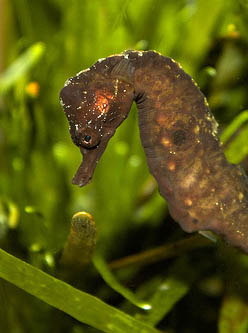 |
Hippocampus capensis
Boulenger, 1900 |
Cape seahorse | EN | S. Africa | |
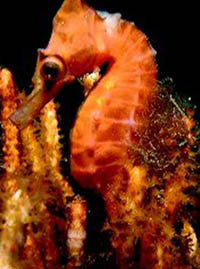 |
H. whitei
Bleeker, 1855 |
White's seahorse | EN | |
Solomon Islands, E. Australia |
 |
Microphis pleurostictus
Peters, 1868 |
Luzon river pipefish; 湖沼腹囊海龍 | EN | Asia | |
 |
Cosmocampus balli Fowler, 1925 |
Ball's pipefish | VU | Eastern Central Pacific | |
 |
Hippocampus algiricus
Kaup, 1856 |
West African seahorse | VU | W. Africa | |
 |
H. barbouri
Jordan & Richardson, 1908 |
Barbour's seahorse | VU | Indo-Pacific | |
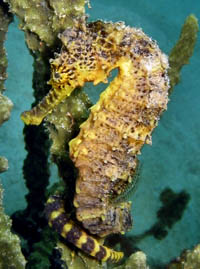 |
H. comes
Cantor, 1849 |
Tiger-tail seahorse | VU | SE Asia | |
 |
H. erectus
Perry, 1810 |
Lined seahorse | VU | W. Atlantic | |
 |
H. histrix
Kaup, 1856 |
Thorny seahorse | VU | |
W. Indian Ocean to Central Pacific |
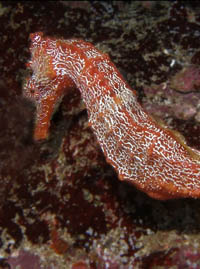 |
H. ingens
Girard, 1858 |
Pacific seahorse | VU | |
California to Peru |
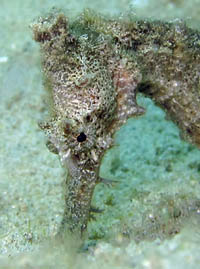 |
H. kelloggi
Jordan & Snyder, 1901 |
Great seahorse | VU | Indo-Pacific to E. Africa to China & Australia | |
 |
H. kuda
Bleeker, 1852 |
Spotted seahorse | VU | Indo-Pacific | |
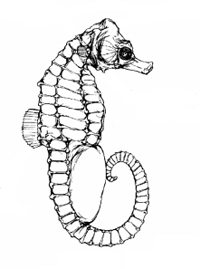 |
H. mohnikei
Bleeker, 1853 |
Japanese seahorse | VU | Japan & Korea to Thailand | |
 |
H. patagonicus
Piacentino & Luzzatto, 2004 |
Patagonian seahorse | VU | Brazil to Argentina | |
 |
H. spinosissimus
Weber, 1913 |
Hedgehog seahorse | VU | |
Indo-Pacific |
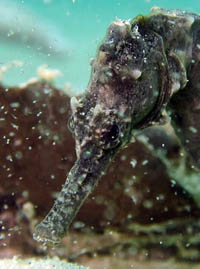 |
H. trimaculatus
Leach, 1814 |
Three-spot seahorse | VU | |
Indo-Pacific |
 |
Microphis insularis Hora, 1925 | Andaman pipefish | VU | Asia |
IUCN Red List key
EX = Extinct
EW = Extinct in the Wild
CR = Critically Endangered
EN = Endangered
VU = Vulnerable
NT = Near Threatened
LC = Least Concern
DD = Data Deficient
NE = Not Evaluated
(Click here for a full explanation of IUCN Red List categories.)
A note on ‘Data Deficient’ species: Species that are assessed as ‘Data Deficient’ are deemed to have insufficient information known about them to carry out a proper conservation assessment. Although such species are not assessed as threatened, we may find out that they in fact are, once enough data is obtained.
Banner image of Pontoh's seahorse (H. pontohi) © Tom van Hout / Guylian Seahorses of the World
[Page updated Dec 2020]

